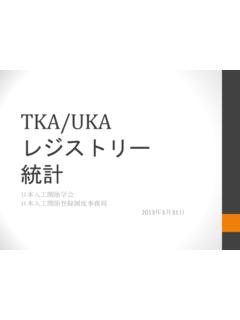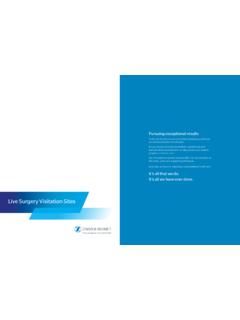Transcription of THE NEW ZEALAND JOINT REGISTRY - NZOA
1 THE NEW ZEALAND JOINT REGISTRY EIGHTEEN YEAR REPORT JANUARY 1999 TO DECEMBER 2016 18 YEARSE mail: Website: of Publication: October 2017 REGISTRY BoardAlastair Rothwell Chairman and REGISTRY Supervisor, Orthopaedic Surgeon Peter Devane Orthopaedic SurgeonSimon Young Orthopaedic Surgeon Brendon Coleman Orthopaedic SurgeonDawson Muir Orthopaedic SurgeonAndrew Oakley Secretary New ZEALAND Orthopaedic Association, Orthopaedic SurgeonHugh Griffin Orthopaedic Industry Liaison AssociationPeter Larmer Arthritis New ZEALAND Andrea Pettett CEO New ZEALAND Orthopaedic Association Toni Hobbs REGISTRY Coordinator Chris Frampton REGISTRY Statistician Annual Report Editorial CommitteeAlastair Rothwell REGISTRY Supervisor Toni Hobbs REGISTRY Coordinator Chris Frampton StatisticianJames Taylor Hip and kneeDawson Muir AnkleKhalid Mohammed Shoulder and elbow Copyright The New ZEALAND JOINT REGISTRY 2017 Editorial CommentsP.
2 3 The New ZEALAND JOINT REGISTRY Annual Report 2013 Editorial Comment 4 Acknowledgments 8 Participating Hospitals and Coordinators 9 Profile of Average New ZEALAND Orthopaedic Surgeon 11 Development since the Introduction of the REGISTRY 12 Inclusion of other JOINT Replacement Arthroplasties 14 Number of Joints Analysed - Category Totals 15 Hip Arthroplasty 16 knee Arthroplasty 82 Unicompartmental knee Arthroplasty 115 Ankle Arthroplasty 125 Shoulder Arthroplasty 130 Elbow Arthroplasty 144 Lumbar Disc Replacement 149 Cervical Disc Replacement 151 Reoperation without Replacement or Removal of any Prosthetic Components 152 Appendices:- Appendix 1 - Oxford 12 Questionnaire References 153- Appendix 2 - Publications 154- Appendix 3 - Prosthesis Inventory 156- Appendix 4 - Data forms 159- Appendix 5 - Oxford 12 Questionnaire forms 173 CONTENTSThe New ZEALAND JOINT RegistryP.
3 4 Editorial CommentsIn this year s report the format of previous years has been followed such that each arthroplasty section is self-contained. This does, however, result in a certain amount of intersection total number of registered JOINT arthroplasties at 31st of December 2016 was 259,859, which had been performed on 178,442 individual patients, of which 36,548 (21%) have died during the 18 year period. The number of observed component years (ocys) contained within the REGISTRY is now well in excess of one million. The increase of 20,417 registered joints for 2016 compared to the 19,586 in 2015 represents an overall annual gain of compared to the percentage gain of , in 2015. When compared to 2015 primary registrations the big gains were for ankles (18%); knees ( ); hips ( ) and unicompartmental knees ( ).
4 There were decreases of for shoulder and 5% for elbow registrations. The proportion of knees to hips rose slightly from in 2015 to in 2016. The mean BMIs are (knees) and (hips) but there are significant numbers of morbidly obese (BMI>40) people receiving for previous years, analyses of revision data has been confined to primary registered ArthroplastyThere are 118,993 primary hip arthroplasties in the REGISTRY with an overall revision rate of per 100 ocys (95% confidence interval; ) with a 17 year prosthesis survival of (cemented ; uncemented and hybrid ). In 2016, 46% of primary arthroplasties were uncemented, the same as for hybrid, with cemented at an all time low of 8%. However, the Kaplan Meier (KM) survival curves continue to demonstrate better longer term survival for fully cemented are 1,020 hip prosthesis combinations in the REGISTRY but only 207 (20%) with 50 or more in previous years, the three types of hip fixation have been analysed against the four age bands: less than 55 years; 55-64 years; 65-74 years, and greater than 74 years.
5 The data shows that overall the hybrid hip has the lowest revision ceramic on plastic bearing surface continues to increase in popularity and rose to 37% of total in 2016. The proportion of the metal on metal articulation continues to decline and in 2016 was just 11% of total, all with head sizes <32 mm. The most popular head size overall remains the 32mm and in 2016 this was used in 61% of primary arthroplasties. However, the use of 36mm head sizes also increased1% in 2016, owing to the increasing use of the ceramic >36 mm head which has so far been vindicated as the revision rate remains low at a mean of years. On the other hand, metal on metal articulations fare poorly when revision rates are analysed against head size, bearing surface materials, age bands and cemented/uncemented/hybrid variants of the same prosthesis.
6 Further reinforcement is from the survival curves for bearing an earlier response to adverse publicity the revision rates for combinations with components manufactured from different companies (component mismatches) have been calculated for 10 mismatches with more than 500 implantations. Just the Spectron/Duraloc and the Exeter/Duraloc combinations have significantly higher revision rates than the overall rate of /100 ocys @ the 95% confidence use of cross linked polyethylene continues its upward trend, making up of the total polyethylene in Corail/Pinnacle combination remains currently the most popular but the ExeterV40/ Trident combination has accumulated the most component years at 47,230 from 8,332 primary arthroplasties and has the very low revision rate of rates for individual hip component combinations (minimum of 50 primary procedures)
7 Assembled in order of numbers of arthroplasties as well as revision rates have again been calculated as well as the tables listing combinations by fixation method to make it easier for readers to determine the combination options used within the three types of prosthesis fixation. There is also the table of prosthesis combinations based on the femoral component which should help readers find specific combinations, Twinsys cemented/Pinnacle, MLtaper/TTDelta and Echo bi-metric /ContinuumTM, which are still currently being used have revision rates significantly higher (p< ) than the overall rate of ocys. All three reached the 50 implantation cut off for the first time and their very high revision rates, ranging from to are somewhat is also worth noting that the revision rate for the 1,297 monoblock stems which have been implanted for an average of 11 years is very low at rates for X linked and standard polyethylene have again been compared for both metal and ceramic heads.
8 This demonstrated that the combination of ceramic head with X linked polyethylene has a significantly lower revision rate compared to the standard polyethylene varieties used with both the metal and ceramic heads. EDITORIAL COMMENTIt is our great pleasure to present the eighteen year report of the New ZEALAND Orthopaedic Association s New ZEALAND JOINT 5 The New ZEALAND JOINT RegistryEditorial CommentsKM survival curves for some of the hip combinations with a minimum of 1,500 arthroplasties and 10 years of analysable data have once again been included as well as 12 year survival curves for those combinations with a minimum of 2,000 procedures. It is noted that the Exeter combinations, except for Exeter/Contemporary, are among the better and the Spectron combinations among the poorer survival curves.
9 Again this year the survival of minor (defined as replacement of liners, bearings, heads, patellae) versus major (defined as replacement of acetabular, femoral, or tibial components +/- minor components) revisions for both hips and knees have been compared. As was shown in previous years, the revision rate after a major revision is significantly better than for a minor revision for both hips and knees, thus suggesting that some minor revisions should have been full analyses recently introduced, including yearly stacked graphs to demonstrate changes over the last 15 years of head size, bearing surfaces, polyethylene and reasons for revision, have again been included, as well as survival curves for; cemented/uncemented stems and cups, different head sizes, the different bearing surfaces and cross linked vs standard polyethylene.
10 All graphically illustrate different survival rate tables and survival curves for the five different BMI groupings demonstrate poorer prosthesis survival for the morbidly obese (BMI>40) group. Resurfacing hip arthroplasty registrations continue to decline from the high of 203 in 2009 with just 70 registered in 2016. The revision rate has again fallen slightly to ocys. The number of primary hip arthroplasties revised within one year of implantation, although fluctuating year on year, has overall gradually increased and in 2016 reached (1832) of those performed in 2015. The previous highest was of those performed in 2007. The reasons for this increasing trend are currently being investigated. The same trend is not seen with knee Best and the Worst Combinations From the 18 years of accumulated data it is possible to recommend the generic component combinations which currently should provide the best long term survival.






